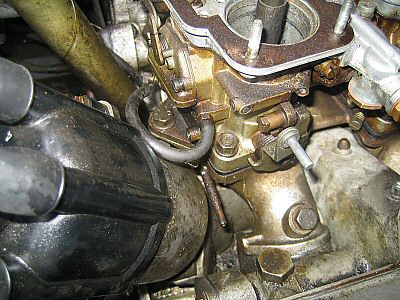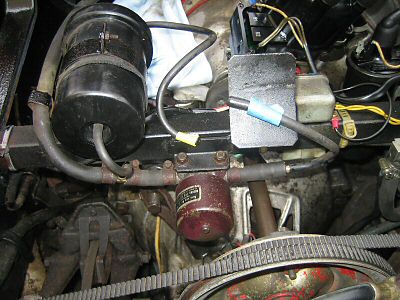My Merak isn't feeling very well.
Can you help? Please! |
| |
|
Any owner having a problem with their Maserati can send me details and I will publish these, together
with any subsequent advice I receive, on this page.
Just drop me a line at maserati123@btopenworld.com |
| |
Even if I don't succeed in helping you with your problems; and I do try, it would help other Maserati owners a great deal if you could let me know how you managed to solve your problems. THANK YOU! |
| |
| |
 |
| |
| |
Harry in Canada writes:
|
"Hi Enrico,
I have a 1979 Merak SS with an intermittent starter problem.
Every now and then when I turn the key I hear a glunk as the solenoid fires into the ring gear and it kills all electrical power to the car. No power at all.
I disconnect the battery and then reconnect it and this brings the power back on. It will usually start then or sometimes kicks off again.
Any ideas as to this problem? Starter was refurbished a few years back. It also has a new battery.
Thanks,
Harry." |
| |
 |
| |
Reply from Roger:
Re: Merak - Starter problems. |
|
"My Merak SS had a starter problem some years ago, but it was poor contacts
at the starter motor and it did not kill electrical power completely. A local car repairer specializing in electricals was able to do a refurbishment of the starter motor.
Harry's problem sounds different, as if there is a short circuit somewhere that is causing power to drain and then shut down. I once experienced this
on my car about a year ago. When I disconnected and reconnected the battery via its isolator all was ok and the problem has never recurred. I puzzled
over it but in the end could only put it down to "Italian electrics"; maybe a wasp had sat across some terminals!
I think the only thing to do is get an auto electrician to trace the problem. The starter motor on a Merak is very difficult to get at unfortunately. When mine was refurbished it was quite expensive in labour costs to get it off the car and replaced; the refurbishment was quite cheap.
Hope this helps.
Regards,
Roger." |
| |
| |
 |
| |
| |
Roger in the UK writes:
|
"Hi Enrico,
Recently I had great difficulty getting my Merak SS to pass the MOT CO emission test, and was wondering how other Merak owners have fared.
Regards,
Roger."
My experiences of getting a Merak SS through the MOT CO emission test:
The Merak, in common with similar cars of its era which run on multiple carburettors, produces a high level of CO (carbon monoxide) in the exhaust emission, particularly at idle speed. This should not really be a problem; this is how the car was designed to perform. I understand that in the Merak the internal shape of the combustion chamber and the resultant gas flows tend to further increase the CO level.
Unfortunately the MOT test which is now in force does not take into account the operating characteristics of these and similar cars when it comes to the test for CO emission % at idle. The maximum allowed level of CO at idle, for cars first used between 1/8/75 and 31/7/86 is 4.50%.
If you have an early Merak, first used before 1/8/75, then youíre in luck, the emission test is just a visual check, so presumably if itís not too smoky youíre ok!
If you are fortunate enough to have a sympathetic MOT tester they will disregard the results of the CO test, or simply not perform the test (gas probe in the exhaust pipe, linked to computer readout). It seems that testers of the sympathetic variety are maybe on the decline now.
So in order to get a Merak through the emissions test one has to weaken the mixture at idle. How to do this?
Option 1: disconnect the small diameter rubber tube that runs from the back of the inlet manifold to the plastic vacuum tank that sits on the cross member at rear of engine. The vacuum controls the heater flaps. By disconnecting the tube the engine will draw in more air, thus weakening the mixture. You will hear the engine revs increase when you do this. The tube can be disconnected at either the manifold end or the vacuum tank end.
Option 2: screw in each of the six idling mixture adjustment screws by Ĺ turn to weaken the mixture. These screws are situated right at the base of each of the three Weber carburettors; each one points outwards and rearwards at 45 degrees. Note that on the SS (and Iím not sure about earlier models) the rearmost carb has both idle screws pointing the same way Ė rearwards and to nearside*. Do be particularly careful to note the position of the screw head before adjustment, as you need to get it back to this setting within 1/8 turn. Use a good light and record the position of each screw; write it down or take photos.
*The manual says the carbs on an SS are 44 DCNF, with the rearmost being 44/1 DCNF; according to a Maserati specialist the only difference is in the angle of the offside idle screw.
Hereís what happened to me:
1. No adjustments. Failed at CO 10.00%
2. Removed vacuum tube. Failed at CO 7.50%
3. Went home and reset idle screws as per option 2.
4. At retest: Failed at CO 6.50%
5. Removed vacuum tube. Passed at CO 2.88%.
As you can see I needed to make both adjustments, and itís interesting to see how much difference the vacuum tube disconnection makes.
One more thing Ė make sure the engine is thoroughly warm before the test; cold engines give inconsistent readings and the MOT computer is set to record correctly with warm engines. |
| |
| |
 |
| |
| |
Michael in the UK writes:
|
"Hello Enrico,
The vacuum tube on my Merak was connected to the distributor, this has now been disconnected.
The question is where should the tube be connected to. Attached two photos, the vacuum cylinder tube (yellow tape) was attached to the top tube of the carburettor. The bottom of the carburettor also has a second tube which had nothing connected to it. Is this where the tube that was connected to distributor should be connected?


Thank you,
Mike." |
| |
 |
| |
Reply from Roger:
Re: Merak - RHD fuse box. |
|
"In reply to Michaelís question re the tube from carb to distributor:
Itís my understanding that it is correct for there to be no tube connection between carb and distributor. On my Merak SS, the vacuum tube is connected to the lower pipe in Michaelís top photo (and I believe this is correct). My SS would appear not to have an upper pipe/outlet onto which to attach a tube as per Michaelís top photo; is Michaelís an earlier Merak?
The SS carb is a 44 DCNF, on earlier cars I believe itís a 42 DCNF. The vacuum tank drives the heater flaps so Iím told. You can pull that tube off to allow more air into the engine to weaken the mixture to get it past an MOT CO emission test! (Remember to reconnect it!)
Hope this helps,
Roger." |
| |
| |
 |
| |
| |
Cornell in the USA writes:
|
"Hello Enrico,
I just read Femi's (in Atlanta) request for a Merak Muffler.
I have a European muffler that he can have for a template or attempt to restore. I would love to see it go to some use instead of ending up in the scrap pile. It came out of a 1977 SS. He can contact me at email crstull@hotmail.com; I'm in the Seattle area. It's kind of heavy and awkward, but as soon as I get the replacement in hand it's free (with a
few bucks for shipping).
Cornell." |
| |
| |
 |
| |
| |
Max in the USA writes:
|
"Hi Enrico,
I just got my Merak SS 1978 (US model #2282). I plan on restoring it.
I have a couple of questions. Iíve read that the '78 had the ZF Transmission, but others have said no, it is the SM.
1. There is a squealing sound when the clutch is fully depressed. I was told it may be the throw out bearing.
2. When the car is hot, it becomes very difficult to get it from fourth to fifth. The previous owner suggested a heavier oil, and that it my be two springs that donít work properly when it is hot. I do get grinding changing gears. So it may be Synchros. I donít have any other Merak experience to compare it to, unfortunately, to know how smoothly these things should work.
All I have right now is the Manual, Electrical Diagram. Any tips on doing the brakes? Any easier to find compatible parts to use?
Well, sorry for all the questions, Iím new to this. All the other questions youíve answered on your site have been very helpful.
Sincerely,
Max." |
| |
| |
 |
| |
| |
? in ? writes:
|
"The Merak SS is giving me hell again in the hydraulics department. If I drive it for about a half an hour and the pressure light comes on. I noticed that LHM was leaking on to the top of the reservoir. From what I could see it was leaking because the bypass line from the slave cylinder. Is it supposed to by-pass fluid without the clutch depressed?
Does the clutch slave sound like it needs rebuilding?
And if so, Is that something that I could do?." |
| |
 |
| |
Reply from Enrico:
Re: Merak - RHD fuse box. |
|
"Here is an example of an email that stands little chance of receiving any kind of reply.
No name, no location of origin.
Enrico." |
| |
| |
 |
| |
| |
|
MORE MERAK QUESTIONS AND ANSWERS |
| |
|

|
|
To enter Enrico's Maserati Pages CLICK HERE!
Copyright: Enrico's Maserati Pages - © 2000-2008. All rights reserved. |


